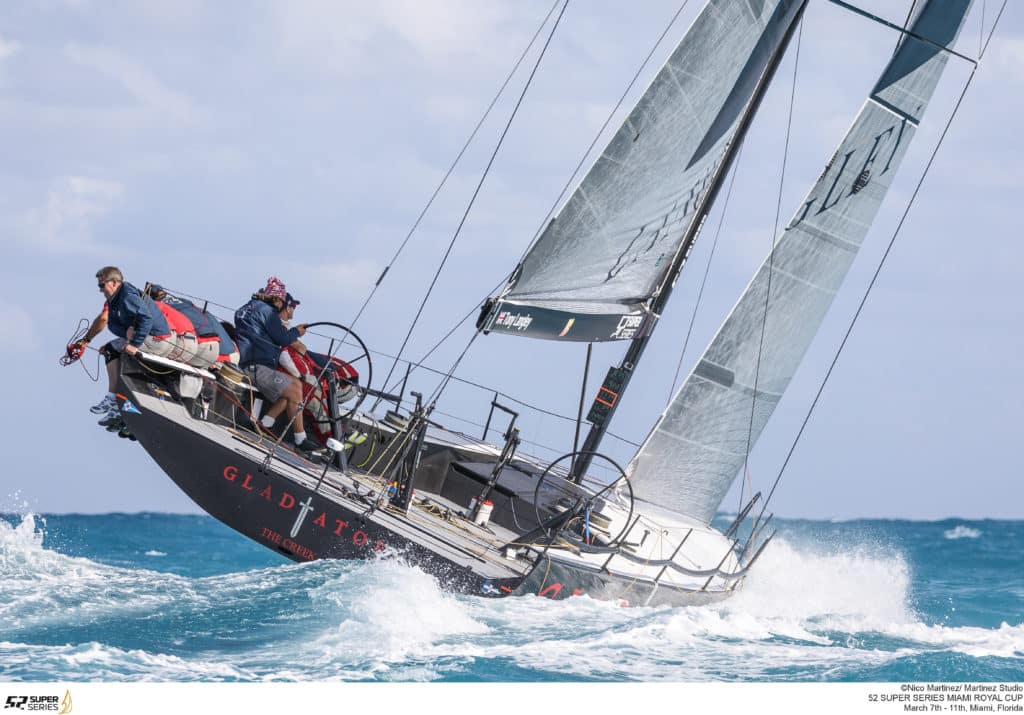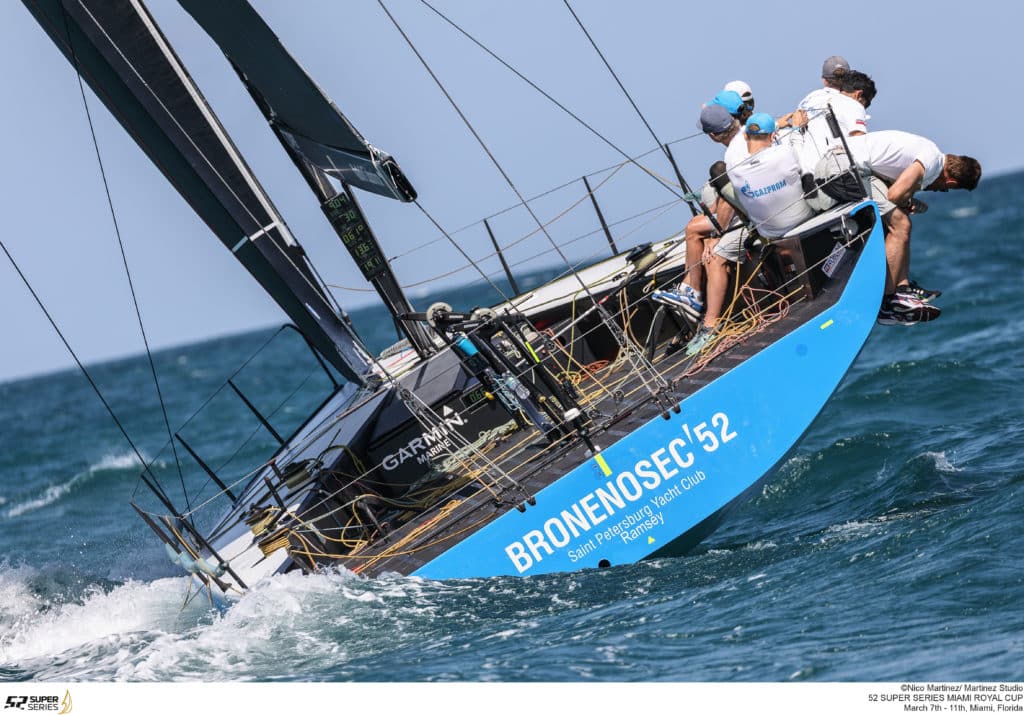
If the wind never changed, there was never a reason to get to one side of the course, or other boats never influenced your positioning, you could always sail to your target speed and angle, or velocity made good, but we know that seldom happens. That’s why you must rely on “moding”: sailing a little higher or lower than your targets for a tactical or strategic advantage, upwind as well as downwind.
Other than the target VMG, I like to think in terms of two other modes. Upwind, there’s high/slow and low/fast. Downwind, there’s low/slow and high/fast. As an example, upwind, right off the starting line, you might find yourself in a position where you have to work hard to stay to windward of a group of boats. Then you switch to a high and slow mode. Or maybe you want to be the first one to reach a shift or puff ahead. Then you switch to the low and fast mode. If you’re sailing downwind, you get to that puff quicker by going to the high and fast mode. If you find yourself too high for the final approach to a leeward mark with not enough time and distance to jibe, then time for low and slow.
How much higher or lower are we talking about when switching into these modes? Not as much as you’d think, the difference between the slow modes, both upwind and down, and the optimum VMG angle, is only about 3 to 5 degrees. The difference between the fast modes, upwind and down, and the optimum VMG angle, is a bit more, sometimes as much as 10 degrees.
A common mistake is to move into a different mode by simply steering those few degrees higher or lower. Do only that, and you’ll never realize the advantage to moding. Here’s a look at the mechanics behind each mode and what you need to do to make moding work for you.
Upwind Low and Fast
Make the boat go fast forward by reducing the rudder angle, which is accomplished by managing your angle of heel. As you bear off, the power from the sail plan will increase, resulting in more heel. This extra heel will make the boat want to turn into the wind. So, you will have to sail with more rudder angle to go straight. This is a bad combination for a higher boatspeed setup because it creates a lot of drag.
The heeled hull shape will push you up, as will the rudder angle. Instead, maintain the same amount of heel that you have been using for your VMG. The first step is to hike harder. That allows you to carry more power, so you can bear away a couple of degrees, without heeling any more. Do that, and the boat will take off. As you hike out, also move aft a bit, which puts the weight on the wider section of the hull, providing more stability.
If hiking alone won’t do the trick, start flattening the sails. This works well for the first couple of degrees down from optimum VMG. A bit of backstay goes a long way because that flattens the jib and opens up the mainsail leech. Once you’re maxed out with flatness, dropping the traveler is next.
You can ease the jib as well, but be careful, because you’ll get to a point where the sail gets deeper, and that creates too much drag. If you can move the jib car outboard, that will help. As you move to a wider angle and drop the main traveler, make sure you keep the main and jib leech parallel by dropping the jib car to leeward as well.
There is a point of diminishing returns in this mode: The first limiting factor is sails. If you’ve got your genoa up and you’re trying to foot in 15 knots of breeze, you’re not going to go any faster. Also, if your boat is very narrow or doesn’t have a lot of righting moment, you might struggle in this mode, especially in a breeze. In both of those situations, you’re just going to overheel.
A good way to judge whether the low mode is working is to watch your bearing on a nearby boat. If you put the bow down and gain bearing on that boat by going fast forward, that’s awesome. If you go down too far, you’ll start losing bearing. This is a sign that you’ve hit the point where you can’t go any faster forward, and you’re starting to go too low. The boat below you is gaining by going higher, so you need to either sail your boat better or not push as low. It works the same downwind. If you start losing bearing, it’s time to shift modes back toward VMG.

Upwind High and Slow
I rarely use this mode, except off the starting line, but it’s good to have in your toolbox because there are those few times when it works. And unlike upwind low and fast, it’s only ever done for a very short amount of time — easily less than a minute.
If you look at the upwind polar curve for almost any boat, the VMG quickly drops off when you sail too high, so there’s limit to how far you can go with this mode. Never sail so high that you start losing flow over the sails and foils. Then the boat will just start sliding sideways. It’s fine to luff the front 10 percent of the jib and have it bubble, and that’s common if you’re in a pretty extreme high mode, but once you start carrying any more than that, it’s always better to just tack away rather than trying to live in the situation.
In this mode, you’re always looking for a little more helm. The helm is more rudder angle and load, giving the boat more side force, and it will naturally want to point. In light or moderate air, heel a couple of degrees more and overtrim the main. You can trim the jib a tiny bit at the same time, but not nearly as much as the main. You don’t want to stop the breeze from going through the slot — that’s death, and the whole sail plan will stall. If you have a traveler, bring the traveler car up in addition to trimming the sheet. If your leech telltales are stalling 50 percent of the time at VMG, you might now see them stalling 80 percent of the time, depending on how far you go into this mode. Trimming the main creates more side force and less drive forward, and by heeling, you’re adding the hull, along with the rudder angle, to prevent the boat from sliding sideways. Those two balance each other out, and the boat will go slower but higher.
Downwind High and Fast
Like upwind low and fast, the goal here is to minimize pull on the rudder. You’re reaching, so expect that it will never be completely neutral. For starters, move the crew aft and out. That will help keep the rudder in the water, create a faster hull shape, and gain righting moment. If that is not enough, start letting the main out. For the first degree or two, you probably need only to ease the main a little. As you go higher, the sheet and vang will be progressively eased more and more. Ideally, you want the mainsail leech to match the spinnaker leech.
The point of diminishing returns in this mode occurs when the main starts luffing. At that point, unless you’re going for a really big puff or shift, you’re sailing too high and fast. Your VMG will be horrible.
Downwind Low and Slow
In this mode, pressure on the sails is everything. The spinnaker trimmer needs to be giving constant feedback about the pressure. Once it starts getting soft, the losses in this mode are dramatic.
Reducing surface friction is equally important, so move forward and maintain heel. Anytime you’re going slowly, surface friction is more important than drag. To look at it another way, if you sail the boat flat, you’re leaving the biggest possible footprint in the water, creating maximum surface friction — just the opposite of what you want.
How much heel? On modern designs — such as J/70s, Melges 32s and Melges 24s — less than 5 degrees of heel downwind becomes very sticky because the boats are pretty wide. With heel, the shape gets more like a banana and less like a plate, so there is less surface area and less skin friction. Moving crew weight forward also helps because it keeps the wide transom out of the water.
Communication
This is probably the most important part of moding. Often when I say, “OK, we need to speed it up a little,” the helmsman will immediately put the bow down. The problem is, if the sails aren’t set for it, the boat will just tip over, and you end up stopping, which is exactly what you don’t want to do.
I tell a lot of helmsmen to listen to what’s going on. Once the call to switch modes is made, there’s always a short delay. The mainsheet might need to be taken out of a self-tailing winch, the jib trimmer might need to go to leeward to ease the sheet, or someone has to pump the backstay. That might take only a few seconds. It certainly shouldn’t be a minute. Then the trimmers let the helm know, saying, “OK, we’re ready.” Once the easing starts — and the helmsman can hear this on the winches, especially the mainsheet winch — then he can bear off.
So a good part of this is driven by the trimmers rather than the helmsman just saying, “I’m going low.” Upwind, you want to sail low and fast? OK, backstay comes on, sails get twisted, the boat comes upright, and then the helmsman bears off to get back to the same amount of heel. And look, the sails are already set, and you’re going faster.









